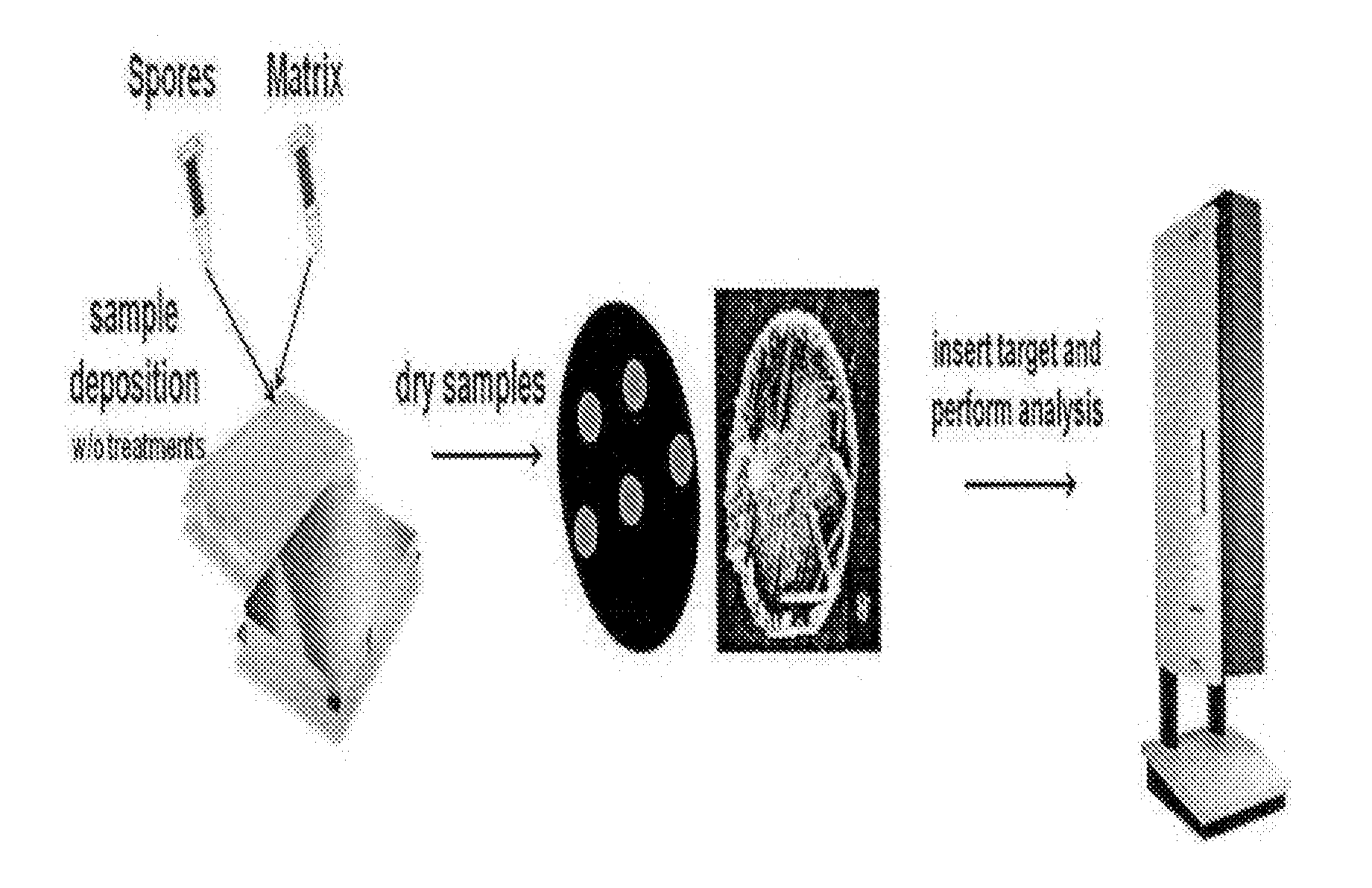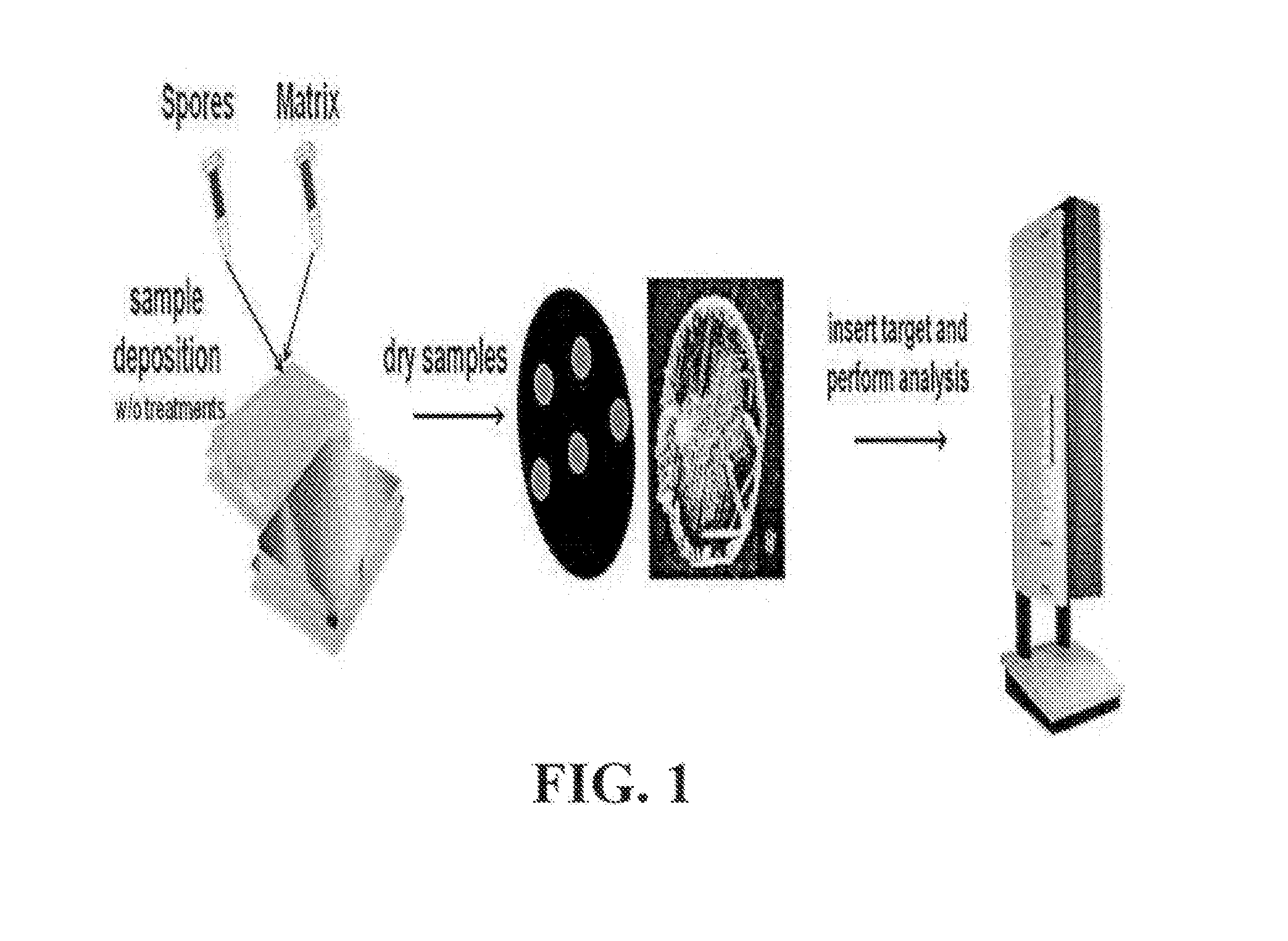METHOD OF IDENTIFICATION OF SPORE-FORMING Bacillus spp. BY DIRECT In-situ ANALYSIS OF MALDI-TOF MASS SPECTROMETRY, AND ANALYSIS SYSTEM
a mass spectrometry and spore-forming technology, applied in the field of direct in-situ analysis analysis system, can solve the problems of difficult to distinguish, inability to identify conventional methods, and expense of maldi-tof mass spectrometry identification, so as to quickly and accurately detect and identify specific bacillus bacteria
- Summary
- Abstract
- Description
- Claims
- Application Information
AI Technical Summary
Benefits of technology
Problems solved by technology
Method used
Image
Examples
example 1
Culturing of Bacillus Bacteria
[0059]For use in the present invention, Bacillus anthracis, Bacillus cereus, Bacillus globigii, Bacillus subtilis and Bacillus thuringiensis were granted from the Korea Centers for Disease Control and Prevention. For sporulation, a single colony of each strain was inoculated into a nutrient broth sporulation medium, and cultured at 32° C. for 2˜4 days with agitation. Culturing was continued until the cells showed more than 99% spore formation, as measured by optical microscopy. The spores thus formed were collected by centrifugation for removal of remnant vegetative cells and cell debris. Sporulation and spore purification were committed under an optical microscope with 400 magnification. The spores were obtained with a purity of 80˜90%. They were suspended at a density of 1×109 CFU / ml in distilled water, and stored at 4° C. until use in experiments.
example 2
[0060]To phylogenetically classify the spores by MALDI-TOF mass spectrometry, 1 μl of B. anthracis spores prepared at a density of 1×108-9 CFU / ml was directly spotted onto MTP 384 target ground steel TF (Bruker Daltonics, Germany) without any pretreatment procedure, and dried at room temperature for 5 min, as shown in FIG. 1. Subsequently, 1 μl of a matrix solution prepared by dissolving a matrix (α-cyano-4-hydroxycinnamic acid (CHCA)) at a concentration of 12 mg / ml in TA2, a 2:1 (vol / vol) mixture of trifluoroacetic acid (TFA, Sigma USA) and acetonitrile (CAN, Sigma, USA) was applied to each dried spore spot on the MALDI target plate, and then allowed to dry at room temperature for 5 min.
[0061]Mass spectra of the spores were obtained using the Autoflex Speed LRF mass spectrometer from Bruker Germany. The pulse ion extraction time was 200 ns. Spectral measurements were carried out in the linear mode of the MBT_FC parameter using an acceleration voltage of 19.51 kV and 18.26 kV at ion...
example 3
[0067]Mass peak profiles of the five different Bacillus spores, that is, Bacillus anthracis, Bacillus cereus, Bacillus globigii, Bacillus subtilis and Bacillus thuringiensis were obtained using the MALDI-TOF MS and analyzed in the same manner as in Example 2 to confirm the discrimination of them from one another.
[0068]The results are summarized in Table 1, below.
TABLE 1BioRelativeBioRelativemarkersSTDEVintensitySTDEVmarkersSTDEVintensitySTDEVm / z2080.66±0.410.11±0.052108.78±0.490.19±0.142096.97±0.470.11±0.042123.44±3.580.19±0.162196.16±0.470.19±0.103079.19±0.660.04±0.012446.03±0.700.12±0.053103.42±0.780.03±0.012473.07±0.520.30±0.083356.79±0.560.24±0.052503.17±0.520.65±0.243418.83±0.570.13±0.032517.88±0.570.35±0.123542.03±0.660.10±0.032523.19±0.660.33±0.113708.67±0.710.14±0.052579.21±0.490.16±0.053807.23±0.720.09±0.082786.00±0.540.32±0.084031.21±0.920.06±0.013075.22±0.580.26±0.064335.03±0.710.09±0.023089.28±0.580.44±0.114424.50±0.570.15±0.043150.47±0.590.10±0.034836.27±0.620.15±0.0333...
PUM
 Login to View More
Login to View More Abstract
Description
Claims
Application Information
 Login to View More
Login to View More - R&D
- Intellectual Property
- Life Sciences
- Materials
- Tech Scout
- Unparalleled Data Quality
- Higher Quality Content
- 60% Fewer Hallucinations
Browse by: Latest US Patents, China's latest patents, Technical Efficacy Thesaurus, Application Domain, Technology Topic, Popular Technical Reports.
© 2025 PatSnap. All rights reserved.Legal|Privacy policy|Modern Slavery Act Transparency Statement|Sitemap|About US| Contact US: help@patsnap.com



